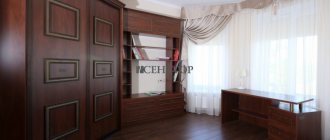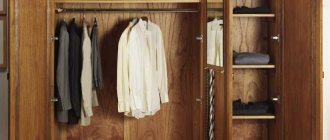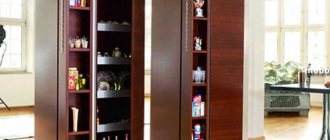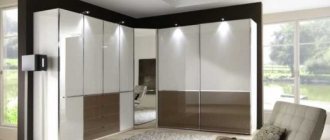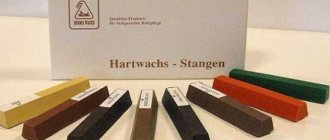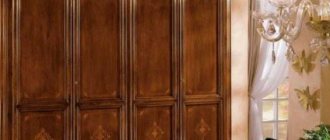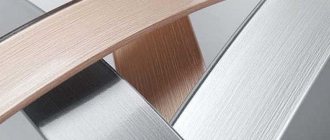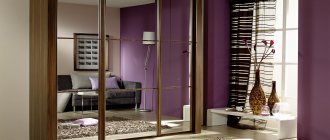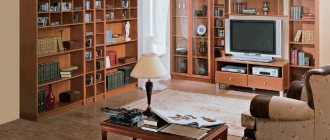Lockers for changing rooms » Useful articles » Metal lockers for workers
Special furniture for changing clothes has been used by civilized humanity since ancient times.
Throughout our lives, we use this simple furniture, from childhood to very old age. After all, we need such furniture in nurseries, in educational institutions, and in sports organizations, when vacationing at resorts (especially relevant for the beach), at work (both for working personnel and for office employees).
Currently, a huge range of such special furniture for changing clothes is produced, which is used, among other things, for secure storage of your clothes, as well as personal belongings.
With the industrial development of our country, specialized furniture for workers, namely a metal cabinet for workers, became increasingly in demand.
The history of the origin of metal cabinets
The word “cabinet” has German roots (Schaffen - to put in order), but the very concept of “a place to store things” came to us, rather, from the famous French “cabinet” (it appeared around the 16th century: someone accidentally installed a chest on the underframe). In general, in the Middle Ages, it was not clothes that were originally stored in the closet, but weapons. Later, this piece of furniture began to be distinguished by its purpose and named accordingly. In its usual form, it has double doors, behind which there is hidden space for hanging clothes, as well as shelves.
Some of the cabinets, invented many centuries ago, have changed beyond recognition, having lost their original functions. Some even in modern design look almost the same as before.
Nuances of choice using examples
If you need a good wardrobe, pay attention to the manufacturing company; you need an experienced organization that has modern equipment, guarantees real quality and offers reasonable prices.
Trusted companies care about the high quality of their products, so high-quality sheets of metal and fasteners are used in production, and powder-polymer paint is used to create a durable coating. Finished products can be painted in any colors that are available in the standard RAL palette.
A safe cabinet in which you can store jewelry and money is made of metal with a thickness of 1.5 mm to 3 mm. Inside the piece of furniture there should be shelves, the height of which can be adjusted, and special trays.
These products are sufficiently durable; they are installed in private homes, apartments, office premises and various institutions.
Metal safes are divided into fire-resistant and burglary-resistant; there are also fire-burglar-resistant models that provide a combination of functions.
A gun cabinet serves as a place to store long-barreled weapons; a collector will definitely need such an item. The cabinet is divided into 2 sections: one of them stores weapons, and the other stores ammunition.
If desired, the owner can install shelves for accessories; they are secured using special fasteners on the walls. There are 2 locks in the locking system; both locking mechanisms must be used simultaneously.
There are various versions of gun cabinets, which differ in different capacities and heights.
Modern types of metal cabinets
Different types of metal products for interiors have structural and functional differences. They are often equipped with all kinds of storage boxes, crossbars, small benches, mirrors - for convenience.
There are samples that have built-in dryers. They are often purchased by construction, installation and repair companies so that people performing their duties outside (in any weather) can, if necessary, quickly dry their work clothes or work uniforms.
For small office spaces where it is not possible to install a storage box on the floor, a wall-mounted or wall-mounted metal box is an excellent solution. Not only does it help keep personal items in order (for example, in changing rooms), but it also saves space.
Currently, a metal storage cabinet with a roof that has a slight slope is in great demand. This type of design allows you to solve the problem of forgotten little things that are placed on the top panel. From the inclined surface, things simply roll into the hands of the owner. And it's easier to wash.
If special furniture is used in some auxiliary rooms for storing personal belongings and personnel clothing, it is equipped with locks (padlocks or zip locks) with hinges. It is very important to install a ventilation grill inside.
To store documents, magazines, books and other items, institutions and organizations also install all kinds of metal shelves and racks. This is a very smart approach - such structures are designed to bear a lot of weight, so they will not bend or break under the weight of papers and other office paraphernalia.
Recommended reading
- Cutting copper with a laser: advantages and disadvantages of technology
- Types of metal cutting: industrial applications
- Metalworking according to drawings: convenient and profitable
Similar racks are often found in warehouse areas. They are placed vertically from the floor and almost to the ceiling at a certain interval (the so-called open storage method). These metal sections can be easily disassembled, moved to another place and reassembled in the same way - this is provided for by their design. It is also convenient that the distance between the shelves is adjustable: you yourself select the option that is optimal for use in specific conditions.
There are different types of metal products intended for storage:
- Fireproof cabinets.
A distinctive feature of this type is the presence of double walls, between which a fire-resistant material is inserted (usually mineral or stone wool). This design allows the contents to remain intact in the event of exposure to an open flame.
Products of this type are divided into:
- safes (ensure the safety of valuable property and are equipped with a secret locking system);
- cabinets for important documents (their main purpose is to protect papers from fire; the locking elements are quite primitive).
- Furniture for organized storage of documentation.
The purpose of the products is to keep business papers, as well as information on other media (photos, CDs, memory cards) in order and safe. Typically these are sheet steel cabinets with lockable doors.
They are made in different modifications, depending on the size and type of intended contents (binders, files, cases, boxes, etc.). Compared to fireproof cabinets, this is a less expensive option: without double walls and a guarantee of fire protection.
- Card indexes.
In cases where it is necessary to place and group a large number of documents (archives, accounting reports, etc.), specially designed blocks are used. They usually contain deep drawers that hold folders of certain sizes.
- Safes for weapons.
By law, all owners of hunting, sporting, defensive and other types of firearms are required to keep them in a special metal box under a secure lock that is burglar-proof.
When choosing a gun safe, you must be guided by:
- the number of weapons that will be placed inside;
- the size of each copy;
- volume of cartridges, accessories and other additional elements.
- Wardrobes for clothes.
A common type of metal cabinets in enterprises and offices: in locker rooms, utility rooms, and common areas. Models differ in size, shape and number of compartments and shelves.
- Handbag women.
They are available in almost all shopping centers and supermarkets: metal boxes for storing hand luggage, packages and other things that you do not want to bring into the shopping area.
- Key holders.
A convenient and functional option for storing keys (with the ability to quickly find what you need) and protecting them from strangers. They are selected based on the number of storage units and location (products come in different sizes).
- Metal mailboxes.
As a rule, such blocks are located at post offices, in the offices of large companies, and in bank branches. They are intended for receiving and sending correspondence. Letters and documents are laid out through special slots in the doors of the cells or using a lid common to all compartments. The people to whom the messages are addressed open individual boxes, each with their own key.
- Metal wardrobes.
These products are used in organizations and archival institutions for systematic storage of documents. They differ from accounting cabinets in that they have a sliding door mechanism, which makes it possible to organize document storage even in small rooms.
- Deposit or escrow cabinets.
This is metal furniture of a particularly reliable design. Its function is the maximum possible safety of valuables. Wherever there is a need to leave valuables for temporary storage (in banks, hotels, fitness centers and other places), similar cabinets are installed.
Varieties
Most wardrobe systems can be made of metal. The exception is classic cabinet shelving made of chipboard. Types of cabinets:
- Modular: sections, rods, shelves, boxes, drawers are attached to a metal frame. Elements can be rearranged, removed, or new ones added.
- Columned: columns made of profiles or pipes are installed in the room, with a height from ceiling to floor. Between them there are shelves, drawers, and rods.
- Cellular: metal guides are attached to the wall of the room, on which the remaining structural parts are placed.
- Combined system: combines different options for the frame, fasteners, and arrangement of modules.
Types of wardrobe hangers, reasons for popularity
The metal structure of a wardrobe can contain elements from other materials: wood, chipboard, MDF, plastic. On such racks you can store many large and small items for various purposes. For this purpose, baskets, boxes, fabric trunks, and covers are used.
Columned
Modular
Cellular
Combined
Types of locks in metal cabinets
In the matter of protecting valuables, important documents and other property from theft, the primary role is played not so much by the design of the storage facility, but by the reliability of its locks. Only a high-quality locking system in tandem with a durable casing can prevent illegal opening of the cabinet and theft of its contents.
So, the main function of locking systems is to prevent doors and sashes from being broken into. Today on the market you can find locks for every taste and budget. They differ not only in the manufacturer's trademark, but also in the installation method, design and, most importantly, burglary resistance, or burglary resistance. It is the resistance of the model to hacking that you should first of all pay attention to when choosing. According to this parameter, locking mechanisms are divided into several classes:
- First class: weak resistance to burglary.
Locks of this level are installed, by and large, only to keep the door closed and to prevent children, animals, insects from reaching the contents, or dust from getting inside. Simply put, this is a latch or latch.
You cannot keep any valuables in cabinets with such locks; they will not protect you from burglars. Rather, they are built in for the safety of people: for example, so that children cannot climb into the distribution box in the entrance.
- Second class: average resistance to burglary.
This category includes mortise, rim and padlocks, which are externally difficult to distinguish from analogues of a higher level of reliability. But there is a difference: the latch and the mate are made from cheap steel grades, which have much less strength.
Employers usually install such locking mechanisms in locker rooms or utility rooms - in lockers with employee clothing and equipment.
- Third class: high resistance to burglary.
Safes are equipped with overhead locking mechanisms of this type: for weapons or for storing especially valuable items. Durable metals – stainless steel – are used in the manufacture of locks: they are resistant to strong short-term mechanical loads.
- Fourth class: extremely high resistance to burglary.
Such locking systems are used in extremely reliable safes, which is why they themselves are characterized by the maximum degree of protection.
It’s not just the burglary resistance class that needs to be taken into account when choosing a lock for metal furniture. The shape, operating principle, and installation method also matter. The combination of these parameters will help you find a cabinet that is both reliable and functional.
According to the installation method, locks are also divided into several categories:
- mortise (placed into the body of the door - they cut into it);
- overhead (can be attached to the inside of the door structure flush with the striker plate);
- hinged (as the name suggests, hung on hinges).
According to the principle of operation, it is customary to distinguish between locking systems:
- code;
- magnetic;
- rotary;
- sliding (sliding) and others.
Ease of use and degree of security against unauthorized opening depend to a greater or lesser extent on the modification. Therefore, it is worth carefully studying the main characteristics of the most popular locking systems.
Types of material
There are two materials used to make metal systems: steel and aluminum. The latter came to this field of application not so long ago, but quickly became a powerful competitor to steel products. The features of these metals are discussed below:
- Steel construction is significantly cheaper, but has several significant disadvantages. The material is susceptible to corrosion, so all parts are coated with epoxy paint, which successfully protects the metal from destruction. But if the coating was of poor quality or chips appeared during use, then after a while the steel will begin to rust. Humid air in the room will greatly speed up the process. In addition, such a system is quite heavy; in a living room it looks massive.
- An aluminum dressing room is a light, visually airy structure, but at the same time very durable and able to withstand heavy loads. This metal does not rust, so does not need to be painted. Aluminum parts are lightweight, the entire structure can be assembled on your own, and after installation, the modules can be moved along with your things. All these advantages determine the cost of such a dressing room - it will cost much more than a steel or cabinet made of furniture board.
Aluminum wardrobe systems are ideal for rented housing - such a lightweight structure can be disassembled and transported to a new location.
The choice of material depends not only on the properties of the metals, but also on the type of system being planned. For columnar wardrobes, chrome-plated steel pipes are often used, which go well with shelves made of furniture board or solid wood. Such designs look impressive, but voluminous. In order not to burden the space, a mesh or frame system is assembled from an aluminum profile. Such dressing rooms are mobile; during use, their contents can change and move at the request of the owner.
Criteria for choosing doors for dressing rooms, variety of their designs
Aluminum
Steel
Characteristics of locking systems for metal cabinets
- Mortise.
They are presented on the market in different variations, the main differences of which are the shape of the key and the design of the core:
- With a triangular key.
This is the simplest modification used for electrical boxes. You can open such a lock without a key in a matter of seconds using primitive screwdrivers, so there is no question of any resistance to burglary (let alone secrecy) in this case.
When you turn the handle, the latch, scrolling, enters the counter plate on the cabinet frame - that’s the entire mechanism of action.
The design provides for several triangle sizes. Locks with a T-shaped key and a square notch operate on a similar principle.
- Cross keyed.
Currently, a very common model of mortise locks. Most often, it is supplied to cabinets made in handicraft conditions; in addition, this type of lock can be found in electrical panels and other special-purpose structures for which the “burglary resistance” of a triangular key latch is not enough.
The Phillips key has a very sharp head, so it should only be carried in pockets with a strong lining, otherwise it will easily make a hole.
- Under the English key.
This is a universal modification of hidden locks: it can fit into both standard entrance doors and furniture doors.
The resistance to burglary of this type of locking mechanisms is higher than that of locks with a cross and triangular key. In addition, the design provides for the possibility of autonomous replacement of the cylinder in the event of a lock failure or loss (theft) of a key - a very useful advantage.
- Mounted.
Padlocks can have different internal designs, but they have one common feature - a collar. It is inserted into the hinges and secured with the core of the locking structure.
Compared to mortise locks, padlocks are much easier to install - you just need to fix the hinges with a hole of the required diameter on the door (sash) and frame. However, padlocks have low resistance to burglary. To open the system, it is enough to cut off the hinges and clamp or simply disassemble the lock itself, which is located completely outside.
- Code ones.
- Mounted.
Simple, fairly cheap locks. The mechanism of operation is as follows: the clamp is threaded through the loops and closed, after which the combination of numbers on the drum changes. When the code is entered correctly, the latch releases the clamp - the lock is open.
- Keyless mortise.
A fairly simple device, which is a regular latch, which is turned by a handle after the code has been correctly entered. Such a product cannot be called reliable: the combinations of numbers are very simple, they can be the same for a whole batch of locks.
- Mortise with key.
The modification is the same as the previous version, with the only difference being that the latch is opened not by a rotating handle, but by a key. Thus, double protection is created: to open the lock, the combination of numbers and the shape of the key must match.
- Mechanical.
These are completely closed devices in which the code is entered using the appropriate set of keys. The latch opens either automatically (thanks to a spring) or using a lever handle.
- Magnetic.
The specificity of this type of lock is that it is not the turning of the key that moves the tongue, but the magnetic field: it attracts or repels the metal part. Such locking mechanisms come in two modifications:
- mechanical magnetic (a device with a small magnet at the base works simply as a latch or closer);
- electromagnetic (a serious locking system capable of pushing the tongue into the strike plate or pulling it out if necessary, thus opening or closing the door).
Reliability and simplicity of design (there are few moving parts) give the electromagnetic system great advantages over others. But its disadvantage is its complete dependence on electrical power.
- Rotary.
The most famous type of lock today. The most common modification of a rotary locking device is a latch mechanism. Due to the fact that the design has few moving parts, it is quite reliable. However, twist locks are not burglar-resistant.
- Sliding.
Sliding-type locking mechanisms are used in metal cabinets that are highly resistant to burglary. Double-sided door locking is a big plus of these locks. The locking structure is equipped with a simple rotating mechanism that makes horizontal or vertical rods move.
- Crossbars.
The crossbar system includes locking devices of varying levels of complexity. Their distinctive feature is the presence of a sliding structure of vertical rods. Operating principle: using a key, the rotating mechanism is rotated, which activates the sliding rods, which, in turn, enter the upper and lower counter bars or, on the contrary, come out of them.
- With a latch.
When it is necessary to install electrical and communication cabinets, locks with a latch are often used. The resistance to burglary of such structures directly depends on the visor on the door along the line of the rebate. If this part is missing, it will not be difficult for attackers to lift the latch - they can do this through a gap in the vestibule with some curved object.
Locking device options
Since a metal cabinet is designed to store clothes, personal items, bags, every person is interested in ensuring their safety. To do this, a lock is installed on the door, and the key is kept by the owner of the items. Such models are especially relevant for places with a large flow of people.
Scope of application of metal cabinets for changing rooms, their features
There are several types of locks based on the type of installation:
- Mounted ones are the simplest option. The lock is hung on special shackles installed on the door and striker plate.
- Overlays - installed on the front of the door and are characterized by maximum reliability.
- Mortise - mounted on the inside of the door, and the cylinder for opening the lock is cut into the steel leaf itself.
The protection class of each device is different, but the most easily hacked are padlocks, the handles of which can be knocked down, for example, by metal objects. Based on the principle of operation, there are several types of locking devices: coded, magnetic, rotary. The former are considered a popular option for protecting the cabinet from burglary. This design can be presented in all types of locks: padlocks, overhead and mortise. The principle of operation is that the user sets his own code, with which he can open the cabinet door. Most often used in dressing rooms, where visitors often leave especially valuable items and money. It can also be mounted inside a cabinet if it has a small section resembling a safe for storing valuables.
Rotary models are used as an inexpensive locking device. The principle of operation is simple and similar to the mechanism for closing doors with a latch. The key activates an element that pushes a locking device - a tongue or rods - into the counterpart of the lock. The use of such options is relevant when organizing large factory dressing rooms.
Magnetic locks, which do not make noise when closing and are easy to install, are also gaining popularity. Their main disadvantage is their dependence on the presence of voltage in the electrical network.
Mounted
Overhead
Mortise
Code
Magnetic
Turning
Types of metal wardrobes
For the convenience of employees and visitors, many enterprises install special furniture for clothes so that people can undress and leave their belongings in peace. Such products can often be found in factories, offices, educational and medical institutions, as well as in gyms and swimming pools. The range of wardrobes made of metal is currently large, but in order to make the right choice, you need to know the specifics of existing models.
The undoubted advantages of metal equipment for locker rooms include:
- resistance to temperature changes and increased humidity (no deformation);
- fire safety (does not burn out when exposed to fire);
- environmental friendliness (metal is not harmful to humans and the environment);
- ease of operation (does not require special care - just remove dust and dirt with a cloth);
- durability;
- immunity to rust (products are coated with an anti-corrosion layer);
- ease of use (there are additional compartments);
- multifunctionality (there are many shelves, crossbars, hooks and other devices inside);
- relative security (usually the doors are locked with a key);
- efficiency.
Metal wardrobes can have different designs, according to which they are divided into types:
- single-section: with one door, hangers, shoe shelves, a compartment for hats included, different sizes, standard height - 180 cm;
- multi-sectional: with two, three or more compartments (and doors), designed to store things of different people.
In addition, in locker rooms, some types of metal products for clothing can be supplemented with legs, furniture wheels, a corner lid, a towel holder, an additional shelf that can be pulled out, and always ventilation grilles.
Modern metal furniture can be not only the standard gray color - currently manufacturers have a rich palette of shades in their arsenal. In addition, the outer layer of the product must be coated with a special protective anti-corrosion paint.
The design of the metal cabinets is well thought out. The doors open at an angle of 180°, and there is a ventilation opening on top for natural air circulation. This is a big plus in places where clothes are wet (swimming pools, gyms, fitness centers) - storing them in a tightly locked space is unhygienic. So these metal products help organize the locker room area ergonomically, comfortably and attractively.
A standard metal wardrobe contains:
- top shelf (for storing hats, scarves, bags);
- middle compartment with a metal rod (for placing hangers under clothes);
- durable base (capable of supporting shoes, bags, heavy objects).
The most caring manufacturers equip cabinets with additional elements for the convenience of users:
- hooks on the inside of the door (for light clothes or towels);
- a cover made of thick fabric (to protect wardrobe items from dirt, dust and moisture);
- bottom shelf-limiter (so that things do not get dirty with traces of shoes).
Metal cabinets designed to accommodate clothing and store personal belongings of staff or visitors are available in different modifications:
- Solid body.
Products of this type are characterized by the fact that their main parts are reliably connected by spot welding, rather than with self-tapping screws and rivets. This ensures structural strength for many years of use. A special wear-resistant fireproof coating is applied on top. Metal solid furniture is supplied already assembled, in individual corrugated cardboard packaging. Such equipment is very heavy, so it must be immediately installed in a pre-prepared permanent place.
- Collapsible.
Perhaps this is one of the most popular types of metal wardrobe. Spacious single-door or double-door wardrobes, which fit perfectly into any interior due to their design, are often used both in offices and in production, in warehouses, utility rooms and other rooms - where there is a need to store outerwear for some time. The high-strength material from which the product is made guarantees that it will last a very long time. Supplied unassembled, the location can be easily changed if desired.
- Modular.
Modular wardrobes are very popular as furniture for locker rooms in medical, educational, and sports institutions, especially in kindergartens and swimming pools. The design of the product makes it easy to attach additional sections and elements of the same series to the assembled group, and they do not take up much space.
This is very convenient, which is why various organizations willingly order such furniture. Another undoubted advantage is the variety of shapes and colors that you can choose for the elements of the modular series, buying ready-made or making an individual order.
How to choose?
To buy the “right” metal cabinet for the workers of your enterprise, you need to consider:
- dimensional parameters of the room allocated for the locker room for workers;
- the number of company personnel who need changing rooms;
- optimally reasonable dimensions of the purchased furniture, which must correspond to the size of the locker room;
- optimal closet interior (shelves, compartments, crossbars, sections for storing hats and shoes, as well as for various small personal items). It should be noted here that, depending on the profile of the enterprise, the uniform of the working personnel can be the most exotic and bulky, which may require some special solutions in the design of cabinets. This issue must also be resolved directly with the manufacturer.
And, of course, you need to request from the seller a certificate of compliance with GOST for the furniture you purchase.
